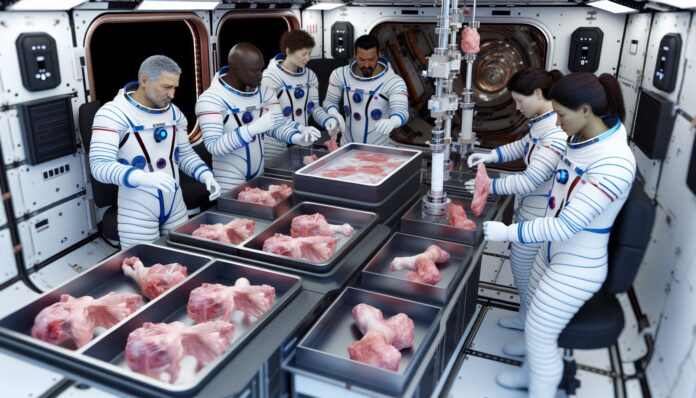In a groundbreaking achievement, scientists aboard the International Space Station (ISS) have successfully 3D printed human muscle tissue in microgravity. This milestone could pave the way for manufacturing entire human organs in space, offering new hope for regenerative medicine and long-duration space missions.
3D Bioprinting in Microgravity: A New Frontier
The experiment was conducted by the German Space Agency (DLR) in collaboration with the University of Dresden and OHB System AG. Using a specialized 3D bioprinter developed for space conditions, the team printed muscle tissue from human cells while orbiting Earth. The microgravity environment of the ISS offers unique advantages for bioprinting, such as the ability to create more complex tissue structures without the need for scaffolding to support them.
On Earth, gravity can distort soft biological materials during the printing process, making it difficult to maintain the desired shape and structure. In space, however, the absence of gravity allows cells to grow and assemble more naturally, mimicking the way tissues form in the human body. This makes the ISS an ideal laboratory for advancing bioprinting technologies.
How the Space Bioprinter Works
The bioprinter used in this mission is a compact, automated device designed to operate in the unique conditions of space. It uses bioinks—gel-like substances containing living cells—to print tissue layer by layer. For this experiment, the bioink was composed of human muscle precursor cells suspended in a nutrient-rich hydrogel. Once printed, the tissue constructs were incubated aboard the ISS to allow the cells to mature and form functional muscle fibers.
After a period of growth, the samples were returned to Earth for analysis. Early results show that the muscle tissue maintained its structure and viability, demonstrating that complex human tissues can be fabricated in space with high fidelity. This success marks a significant step toward the long-term goal of printing entire organs in orbit.
Applications for Space and Earth
The implications of this research are far-reaching. In the context of space exploration, the ability to bioprint tissues and organs could be vital for the health and survival of astronauts on long-duration missions to the Moon or Mars. Medical emergencies in space are difficult to manage due to the lack of immediate access to hospitals or donor organs. On-demand bioprinting could provide life-saving treatments far from Earth.
Back on Earth, this technology could help address the chronic shortage of donor organs. According to the World Health Organization, thousands of patients die each year while waiting for organ transplants. Bioprinting organs in space could eventually become a scalable solution, especially for complex tissues that are difficult to produce under Earth’s gravity.
Challenges and Future Directions
Despite the success of this experiment, several challenges remain before full organs can be printed in space. One major hurdle is vascularization—the process of creating blood vessels within printed tissues to ensure they receive adequate nutrients and oxygen. Without a functioning vascular system, larger tissue constructs cannot survive for long periods.
Researchers are also working on improving the resolution and speed of space bioprinters, as well as developing new bioinks that better mimic the properties of natural tissues. Future missions will likely focus on printing more complex structures, such as heart or liver tissue, and testing their functionality in space and after reentry to Earth.
In the coming years, international collaborations and commercial partnerships are expected to accelerate progress in this field. Companies like SpaceX and Blue Origin are already exploring the potential of space-based manufacturing, and bioprinting could become a key component of this emerging industry.
As the technology matures, we may see the first fully functional, space-printed human organ within the next decade—a development that could revolutionize both medicine and space travel.
Source: Space.com

